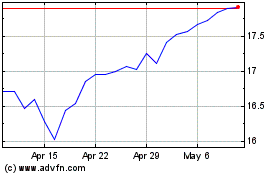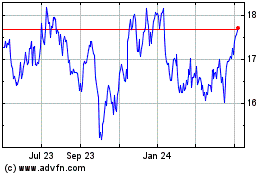By Katherine Blunt and Russell Gold
This article is being republished as part of our daily
reproduction of WSJ.com articles that also appeared in the U.S.
print edition of The Wall Street Journal (November 15, 2018).
California's largest utility suffered its steepest stock plunge
in 16 years Wednesday as concerns grew that potential liability
costs from destructive wildfires threaten the company's financial
future.
Shares in PG&E Corp. fell nearly 22% and its bonds were also
hammered, capping five straight days of losses that have dragged
shares down more than 47%, its worst such stretch on record.
The free fall began after the company reported to state
regulators that one of its transmission lines had malfunctioned
before the start of a massive fire in Northern California. The fire
has now destroyed more than 7,600 single-family homes and killed at
least 48 people.
The San Francisco-based company reported in a securities filing
Tuesday night that it had exhausted its revolving lines of credit
and warned that its $1.4 billion of insurance coverage for
wildfires occurring between Aug. 1 and July 31, 2019, may be
insufficient to cover all potential liability claims against the
company.
Geisha Williams, PG&E's chief executive, said in an
interview that it was premature to speculate about whether the
company would need to seek bankruptcy protection. She said the
company tapped its credit lines to create more financial
flexibility.
"The cause of the fire has not been determined, so it's not
clear if we're going to be held responsible," Ms. Williams said,
adding that it is currently focused on assisting communities and
first responders.
State investigators have yet to determine whether PG&E
equipment caused any current wildfires, or whether the company was
negligent, findings that could trigger state fines as well as fuel
lawsuits from homeowners and others who lost property.
But the utility, already facing billions in potential liability
costs from last year's wildfires, is confronting a sobering
situation without any easy fixes, as an extended drought and
population growth into fire-prone forested areas turns parts of
California into a dangerous tinderbox.
PG&E's Pacific Gas & Electric Co. unit serves about 16
million people from Santa Barbara almost all the way up to the
Oregon border. The company owns and operates hundreds of miles of
electrical wires that crisscross an increasingly dry region at
rising risk of fire, a new reality that California Gov. Jerry Brown
has attributed in part to a changing climate. State investigators
have already concluded PG&E equipment helped spark at least 16
fires last year, generating hundreds of lawsuits.
The company was worth more than $36 billion in September 2017,
before the recent spate of fires in Northern California. It closed
on Wednesday worth $13.27 billion. PG&E cut its dividend and
took a $2.5 billion charge earlier this year.
"The reality is that fire season is year round and fires are
spreading at rates we've never seen before," said Ms. Williams,
PG&E's CEO. "We must work together across all sectors and
disciplines to address this issue with urgency."
Citi analyst Praful Mehta estimated the total damage caused by
the current fire could reach $15 billion, comparable to the 2017
fire damages, though PG&E wouldn't necessarily bear those costs
in full if found liable for the blaze.
Mr. Mehta said those potential liability costs could raise the
risk of bankruptcy for PG&E, which could force the California
Legislature to consider rescuing the company.
"All roads lead to Sacramento," he said. "There is no way they
could face all of those liabilities without a legislative
solution."
PG&E has already sought help from the state. Earlier this
year, it successfully pushed for legislation that would allow it to
pass on wildfire-liability costs to its customers under certain
circumstances. But the bill takes effect in January, leaving the
company currently unprotected from liability claims arising from
the current blaze in Northern California, known as the Camp
Fire.
Another fire, known as the Woolsey Fire, was burning to the
south in parts of Los Angeles and Ventura County that aren't within
PG&E's coverage area.
The liabilities could be enormous. Lawyers who sued PG&E
following devastating fires in 2015 and 2017 are already mobilizing
to sue the company for the Camp Fire.
A coalition of law firms calling itself Northern California Fire
Lawyers filed a negligence lawsuit Tuesday on behalf of more than a
dozen residents affected by the blaze, alleging PG&E failed to
properly maintain its equipment. The lawsuit details what the
lawyers call a "regular pattern of placing its own profits before
the safety of the California residents it serves."
Following the 2017 fires, individuals, municipalities and
insurance companies filed more than 800 civil lawsuits against
PG&E. The first trial in those cases is slated to take place
next September.
Britt Strottman, a lawyer with Baron & Budd who has
successfully sued PG&E over previous fires and a natural-gas
explosion, said the company had neglected safety considerations,
creating the current situation.
"They continue to have a culture where they neglect the
maintenance of their system and divert money that should be used
for safety to executive bonuses," she said.
PG&E spokeswoman Lynsey Paulo strongly disagreed. "Nothing
is more important to PG&E than the safety of our customers, our
communities, our employees and our contractors," she said.
It could take years to sort out fines and liabilities, according
to Height Capital Markets. It estimated that state fire
investigators wouldn't formally determine the cause of the current
fire, including PG&E's role, until next summer, and that
settlements on claims could take until 2020 at the earliest.
PG&E expressed concern last week about the potential for
more wildfires, fueled by the state's Santa Ana winds. It notified
about 70,000 customers that it might turn off their power as a
safety measure. Strong winds can blow electrical lines into trees
or into each other, generating electrical arcs that can drop sparks
and molten material onto dry vegetation. The company ultimately
decided there wasn't enough risk to warrant shutting off the
power.
At 6:15 a.m. on Nov. 8, PG&E detected an outage on a
high-voltage transmission line that connects a century-old dam in
the Sierra Nevada mountains to the rest of the state's power grid.
The problem on the line occurred near Pulga in Northern California.
Fifteen minutes later, a wildfire was reported in that vicinity.
Whipped by high winds, the fire grew quickly into the deadliest in
California history.
--Maria Armental and Sara Randazzo contributed to this
article.
Write to Russell Gold at russell.gold@wsj.com
(END) Dow Jones Newswires
November 15, 2018 02:47 ET (07:47 GMT)
Copyright (c) 2018 Dow Jones & Company, Inc.
PG&E (NYSE:PCG)
Historical Stock Chart
From Mar 2024 to Apr 2024

PG&E (NYSE:PCG)
Historical Stock Chart
From Apr 2023 to Apr 2024
